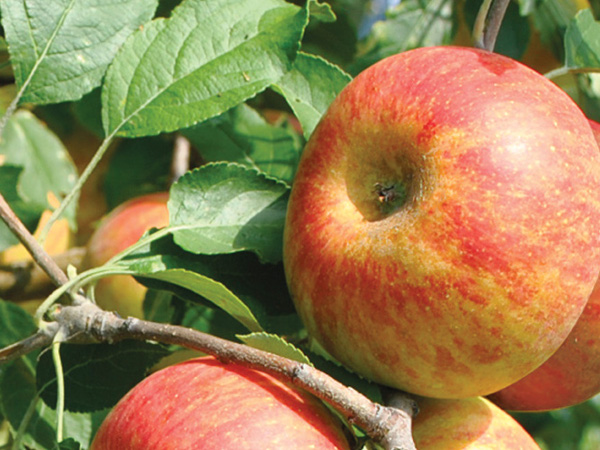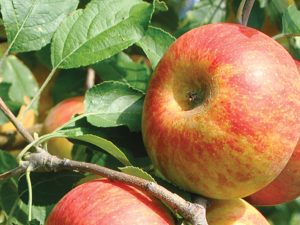“Brambles, in particular, protect and nourish young fruit trees, and on farms bramble clumps can be used to exclude deer and cattle from newly set trees. As the trees age, and the brambles are shaded out, hoofed animals come to eat fallen fruit, and the mature trees are sufficiently hardy to withstand browsing. Our forest ancestors may well have followed some such sequences for orchard evolution, assisted by indigenous birds and mammals.” – Bill Mollison
Contents
What are fruit trees & orchards?
‘Top fruit’ can include apples, pears, plums, cherries, quinces, medlars, chequerberries, mulberries and figs. They’ve all been grown by humans for thousands of years, have played an important part in the monastic tradition, and were very fashionable in Victorian times. Until a few decades ago, the UK grew nearly all its own fruit – almost everyone with a garden had fruit trees. That’s not the case now, and many skills have been lost, such as knowing when the fruit is ripe and ready to pick, or knowing that some fruit needs to be stored before ripening (pears, for example, are often picked under-ripe, and stored until ripe). Interest is beginning to grow again though, as people are becoming more concerned about food and nutrition.

Apples are the most popular top fruit in the UK; there are about 6000 varieties world-wide, and 2000 in this country. The vast majority of trees produce just a few varieties though. Many of the traditional garden and orchard varieties produce fruit that is high in taste and nutrition, but that doesn’t meet the top 10 criteria demanded by supermarkets – i.e. uniformity of shape, shininess, transports well, thick skin that doesn’t bruise etc. (flavour is no. 6, and nutrition isn’t in the top 10).
What are the benefits of fruit trees & orchards?
Flavour & nutrition: fruit picked for supermarkets is often picked under-ripe and put into cold storage for long periods – often several months. On your own trees, fruit can be allowed to grow to ripeness, and the flavour and nutritional value will be improved.
Diversity: we don’t have to stick to the narrow range of supermarket fruits – we can plant some of the rarer varieties that now only exist in one or two collections.
Wildlife: supermarket fruit is usually grown on dwarf trees, in monoculture plantations that are sprayed with chemicals. Home-grown fruit will more often be organic, on standard (i.e. large) trees, and be part of a diverse landscape that is more beneficial to wildlife.

Easy: fruit trees are perennials, don’t need composting (perennials look after their own soil fertility), and just need to be left to get on with producing free fruit every year.
Other yields: fruit trees also provide prunings for pea-sticks or kindling, firewood, waste fruit to feed to animals, leaves for compost and blossom for bees.
Health: fruit is good for us, and if you grow your own, you’re more likely to eat more of it – and children too if they’re involved in picking. Just being outdoors to pick, climb and prune is healthy too.
Beauty: fruit trees will add to the beauty of any garden.

What can I do?
Look after old trees and plant new ones.
Old trees
Old trees are often neglected, and they don’t produce so much or such good quality fruit. The main thing to consider for old trees is pruning – which can be complex, but here are the main things to remember:
Pruning is the cutting back of twigs and branches to remove dead, damaged or diseased wood, and to keep the tree open, allowing in light and air that promotes the growth of fruit. You shouldn’t remove more than 1/3 of twiggy growth in any one year. Remember to prune at the right time of year. Apples and pears: January and February; stone fruits: mid-May to the end of August (otherwise wounds created in winter can let in potentially fatal diseases; not a problem for apples and pears though). Obviously you can’t prune if you don’t have old trees; but sometimes, neighbours will allow you to prune their neglected trees in exchange for some of the fruit it produces. You can have a go at pruning old trees on a course.
New trees
First choose your tree(s); get them from a reputable nursery not the local garden centre – i.e. a nursery that produces the trees themselves by grafting. Choose varieties that will do well in your part of the country (a good nursery can give you loads of advice on this too). Most fruit trees will need a pollination partner (or 2), so make sure you get trees that are known to pollinate each other (or are self-fertile if you only have room for one).

Rootstocks & grafting
Each fruit variety is available on a number of different rootstocks, that will dictate the size of the tree. Make sure you get the one that fits your space. Note that the smaller rootstocks will produce trees that need more care and attention (staking, feeding,etc.) and that can’t cope well with competition; larger rootstocks are not so fussy. But small ones start to give fruit when younger than large ones.
A fruit will not grow true from seed. Human children are often nothing like their parents, and a fruit tree grown from seed might not have the characteristics you want. If you plant 10,000 apple pips, you may only get one good variety (lots of fruit, tasty, not disease-prone). So, since Roman times, people have been taking grafts from trees of known good origin, and grafting them onto rootstock. Now, every Cox’s orange pippin is descended from one original tree. Rootstocks have been developed that control the size of the tree; e.g. a Bramley apple on an M27 rootstock will grow to a maximum of 2m, whereas on a rootstock M25 it will grow to 10m.

You can get rootstocks and grafts from good tree nurseries. You can also learn to graft yourself. Usually nurseries do it for you, and provide you with a small tree, or if you know what graft and rootstock, or what kind of tree you want to end up with, they can graft to order. Unusual varieties can be obtained from the national collection at Brogdale, and they can also graft to order. We know of one specialist nursery – Cool Temperate Nursery in Nottinghamshire – who supply apple trees grown on their own roots, rather than grafted. Research indicates that these trees are better able to cope with poor soils and droughts, and that their fruit has better flavour and nutrition, and keeps better.
See our further info section for step-by-step and month-by-month guides to growing tree fruit.
Specialist(s)
Thanks to Bryn Thomas of Brighton Permaculture Trust for information.
The specialist(s) below will respond to queries on this topic. Please comment in the box at the bottom of the page.

Andy Howard, of The Heritage Fruit Tree Company, and a founder member of the Mid-shires Orchard Group, is a nurseryman who grafts his own heritage fruit trees every year. He is on a mission to bring back traditional varieties of apple, and other fruit, many of which are now endangered.



4 Comments
Grease bands or just the grease…
I have some fruit trees and have ants farming aphids but also want to protect in the autumn from climbing insects etc. I’d like to be organic in my growing, so I don’t want to use a petroleum derived product. The bar on my trees is rough so grease bands are not adequate as the crevices in the bark become the access for any pest. Grease and grease bands are quite expensive and not necessarily organic. So, I’m after an alternative, homemade would be ideal and my searching so far has not come up with anything conclusive.
Do you have any suggestions please? Or methods you have used successfully? Any feedback would be useful.
Thanks very much in advance.
Hi Shaggy, I currently use ( and sale) a fruit tree grease and band alternative, it comes in the shape of a mastic tube (£9.95 each) so is very easy to apply as don’t need to get your hands-on it at all. Uou just put a beading of this sticky glue ( made out of human consumable grade wax and very sticky). Its an insect barrier glue so will help stop aphids as shepherd aunts can’t cross it or winter moths. very easy to apply and can do loads of trees from one tube and now makes life so easy if you have to do a whole orchard ( normally sale a box f12 for that!) don’t know where you are based but i do a lot of apple tree fairs so you could pick one up from there or I can post. The only other option is to adopt a bio dynamic principle ( but involves making unto 3 extra preparations) I can give you more details on how to find out more- which can include companion planting ( most alliums- onions, garlics, can work and leeks have definitely worked well in the past for me. also pro predator plants such as poached egg plants have saved me quite a few times. All the best Andy
Got me a “random” apple tree in my back garden. Came from a discarded apple core, and its right next to a “family apple tree!” So I want to use it as a basis for more by way of grafting. I therefore need some grating compound, and I want to make my own, BUT CANN`T FIND THE METHODOLOGY OR INGREDIENTS!!!! So can you help. Its driving me nuts, so can you help me????
Yes you can make your own grafting compound. The traditional method was to use clay, horse manure and some straw but you would have still had to tie the graft into with rafia straw as well before applying the covering to stop it drying out to quickly. You need a mix which is moist enough to manipulate but also has some rigidity in so you can mould it into an egg shape around the graft. Lot easier to use more modern paraflm stem tape which can get from me or possibly your local florist if you ask nicely. I’m of to do some budding now to save a tree which is the last of its kind . What one so you think ill use? Atb Andy (c) 2017 Andy Howard